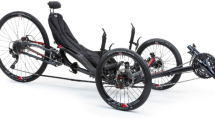Abstract
This paper proposes a method to assist human force acting on electric bike without using costly torque sensors via a model-based impedance control technique. In general, electric bikes are classified into two categories, i.e., pedelec electric bikes and throttle electric bikes. We focus on the system called a pedelec electric bike. It assists human pedaling force using the pedaling information, e.g., pedaling force or speed. To obtain the human’s pedaling information in real-time, it needs physical sensors such as a torque sensor and a velocity sensor. But, these sensors are expensive and weak against external loads. Also, since these sensors are fixed directly to the forced component in a bike system, there are the risks of damage. For these reasons, sensor-less control methods based on a disturbance observer have been studied so far. In this paper, we have proposed a pedaling torque sensor-less power assist method and have applied it to the experimental pedelec electric bike. A power assist control algorithm, designed by employing an impedance model, consists of a PI-type feedback controller, an inverse model-based feedforward controller, and a pedaling torque observer. Finally, we performed experiments and confirmed the effectiveness of a proposed power assist control method.
Similar content being viewed by others
References
Atsushi, K. and Ohnishi, K. (2012). Robust force sensorless control in motion control system. Advanced Motion Control, IEEE, 165–170.
Bickel, R. J. and Tomizuka, M. (1995). Disturbance observer based hybrid impedance control. Proc. American Control Conf., 1, 729–733.
Chang, S. B., Chen, P. C., Chuang, H. S. and Hsiao, C. C. (2012). Velocity control with disturbance observer for pedal-assisted electric bikes. Int. J. Vehicle Mechanics and Mobility 50, 11, 1631–1651.
Chuang, H. S., Chang, S. B., Cheng, M. Y., Lin, W. B., Chou, J. H. and Li, C. Y. (2012). Force-sensorless power assist control design for electric bicycles. Advanced Science Letters, 8, 661–665.
Dill, J. and Rose, G. (2012). Electric bikes and transportation policy: Insights from early adopters. J. Transportation Research Board, 2314, 1–6.
Jeong, C. H., Kim, J. Y. and Jung, D. H. (2015). Research on vehicle stability technology based on wheel force. Int. J. Automotive Technology 16, 3, 435–445.
Kang, D. K. and Kim, M. S. (2015). Hardware-in-loop simulation to evaluate the drive performance of the electric two-wheelers on a motor dynamometer. Int. J. Automotive Technology 16, 6, 1031–1040.
Kim, K. Y., Nam, K. H., Oh, S. H., Fujimoto, H. and Hori, Y. (2012). Two-dimensional assist control for powerassisted wheelchair considering straight and rotational motion decomposition. IEEE Industrial Electronics Society, 4436–4441.
Murakami, T., Nakamura, R., Yu, F. and Ohnishi, K. (1993a). Force sensorless impedance control by disturbance observer. Power Conversion Conf. Record of the., IEEE, 352–357.
Murakami, T., Yu, F. M. and Ohnishi, K. (1993b). Torque sensorless control in multidegree-of-freedom manipulator. IEEE Trans. Industrial Electronics 40, 2, 259–265.
Nam, K. H., Fujimoto, H. and Hori, Y. (2014). Advanced motion control of electric vehicles based on robust lateral tire force control via active front steering. IEEE/ ASME Trans. Mechatronics 19, 1, 289–299.
Nam, K. H., Kim, Y., Oh, S. H. and Hori, Y. (2010). Steering angle-disturbance observer (SA-DOB) based yaw stability control for electric vehicles with in-wheel motors. Int. Conf. Control Automation and Systems, 1303–1307.
Oh, S. H. and Hori, Y. (2008). Generalized discussion on design of force-sensor-less power assist control. IEEE Int. Workshop on Advanced Motion Control, 492–497.
Oh, S. H. and Hori, Y. (2005). Sensor free power assisting control based on velocity control and disturbance observer. Industrial Electronics, Proc. IEEE Int. Symp., 4, 1709–1714.
Oh, S. H., Kong, K. C. and Hori, Y. (2014). Design and analysis of force-sensor-less power-assist control. IEEE Trans. Industrial Electronics 61, 2, 985–993.
Ohnishi, K., Matsui, N. and Hori, Y. (1994). Estimation, identification, and sensorless control in motion control system. Proc. IEEE 82, 8, 1253–1265.
Oonishi, Y., Oh, S. H. and Hori, Y. (2010). A new control method for power-assisted wheelchair based on the surface myoelectric signal. IEEE Trans. Industrial Electronics 57, 9, 3191–3196.
Ou, C. C. and Chen, T. C. (2012). Power-assisted wheelchair design based on a lyapunov torque observer. Int. J. Innovative Computing, Information and Control 8, 12, 8089–8102.
Rose, G. (2012). E-bikes and urban transportation: Emerging issues and unresolved questions. Transportation 39, 1, 81–96.
Salvucci, V., Oh, S. H. and Hori, Y. (2010). New approach to force sensor-less power assist control for high friction and high inertia systems. Industrial Electronics, IEEE Int. Symp., 3559–3564.
Sankaranarayanan, V. and Ravichandran, S. (2015). Torque sensorless control of a human-electric hybrid bicycle. Industrial Instrumentation and Control, Int. Conf., 806–810.
Seki, H., Iso, M. and Hori, Y. (2002). How to design force sensorless power assist robot considering environmental characteristics-position control based or force control based. IEEE Industrial Electronics Society 3, 1, 2255–2260.
Tran, Q. V., Kim, S. H., Lee, K. H., Kang, S. C. and Ryu, J. H. (2015). Force/Torque sensorless impedance control for indirect driven robot-aided gait rehabilitation system. Advanced Intelligent Mechatronics, IEEE Int. Conf., 652–657.
Ugurlu, B., Nishimura, M., Hyodo, K., Kawanishi, M. and Narikiyo, T. (2012). A framework for sensorless torque estimation and control in wearable exoskeletons. Advanced Motion Control, IEEE Int. Workshop, 1–7.
Author information
Authors and Affiliations
Corresponding author
Rights and permissions
About this article
Cite this article
Cheon, D.S., Nam, K.H. Pedaling torque sensor-less power assist control of an electric bike via model-based impedance control. Int.J Automot. Technol. 18, 327–333 (2017). https://doi.org/10.1007/s12239-017-0033-5
Received:
Revised:
Accepted:
Published:
Issue Date:
DOI: https://doi.org/10.1007/s12239-017-0033-5




